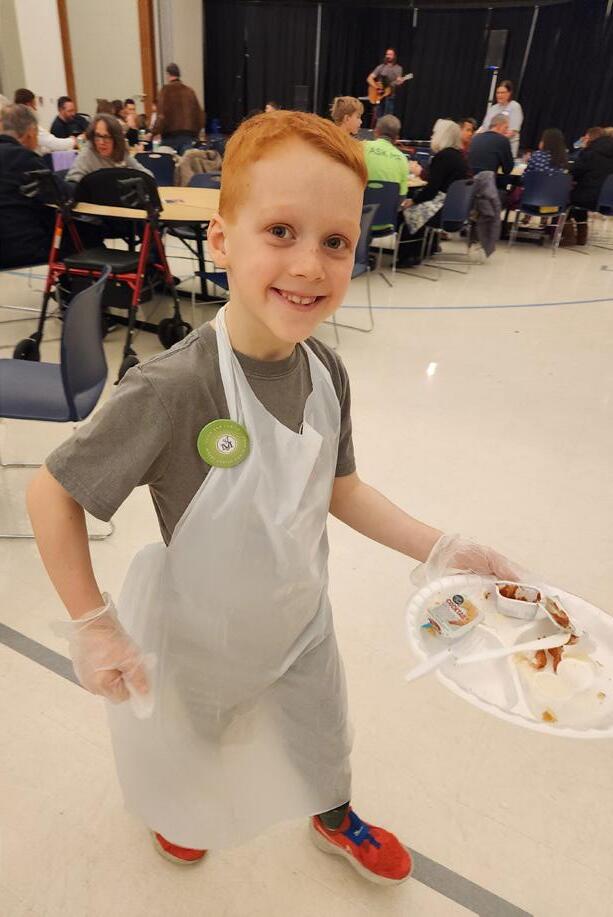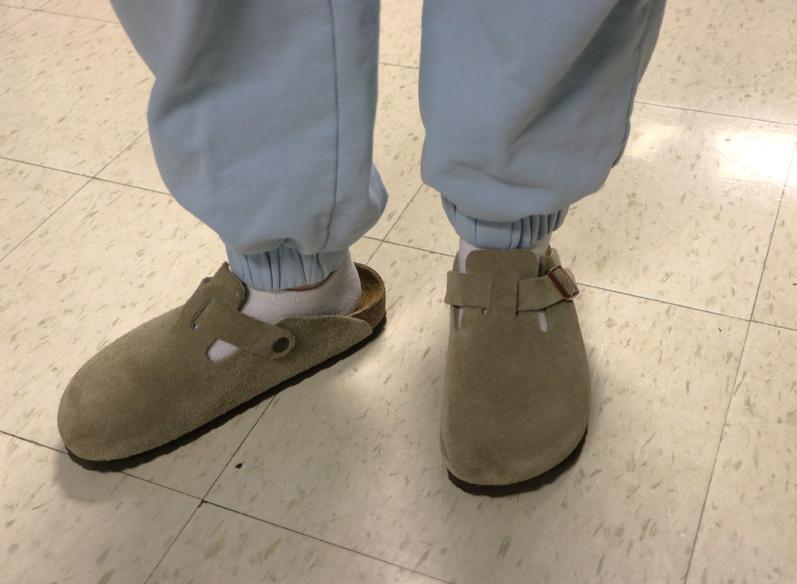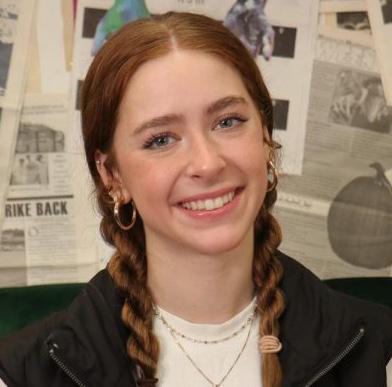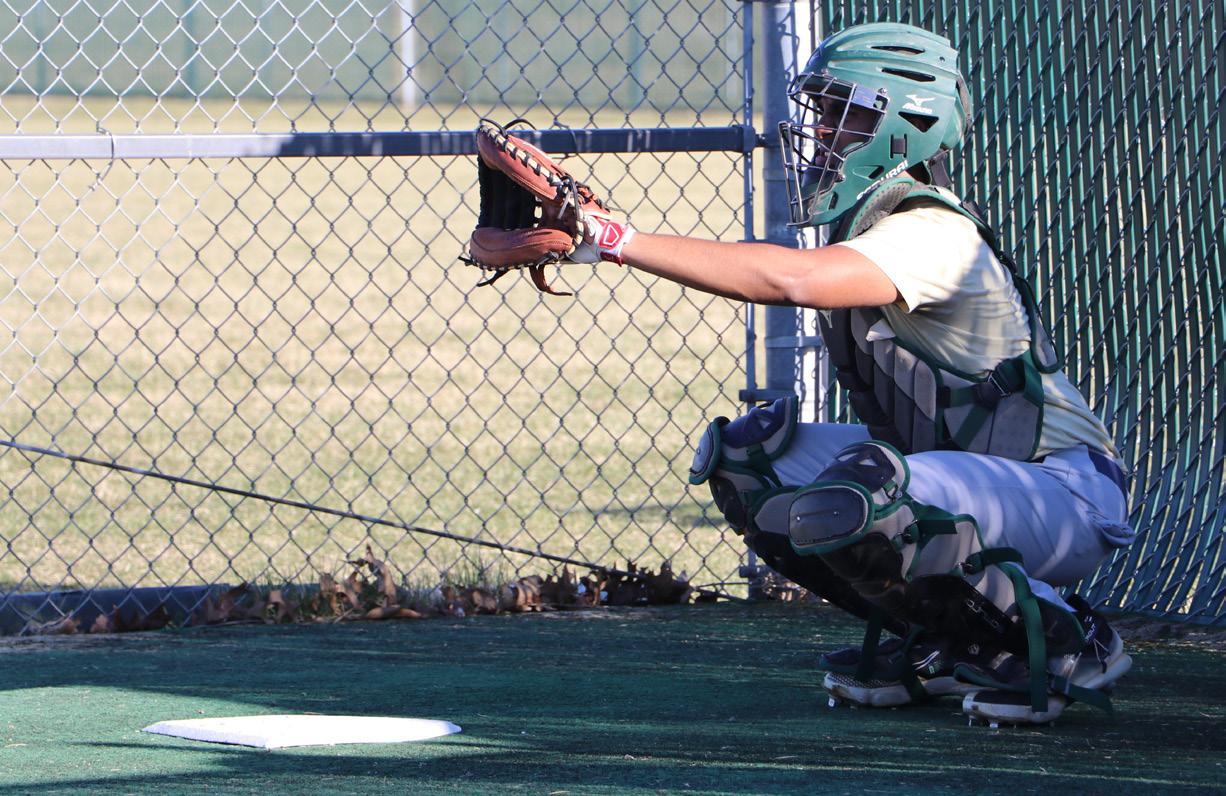
Cybersecurity club aims to fight unsafe online practices.








Cybersecurity club aims to fight unsafe online practices.






According to the Missouri Department of Health, drug overdose was the leading cause of death in 2020 for adults 18-44. A little over 70 percent of these deaths involved opioids. Opioids are readily available as prescription painkillers and concerns are rising about users abusing these highly addictive drugs.
Photoillustration by Layla Shockley
Editor in Chief
Annabelle Miller
Anvi Talyan
Prashu Sidella
Elliott Jorgensen
Willem Hummel
David Moss
Eli Ferguson
Justin Small
Emily Chien
Aubrey Lacavich
Hailey Neuner
Opinions Editor
Claire Lowder
Layla Shockley
Luke Graves
Shreya Das
Kate Jesperson
Elizabeth Bahr
Aiden Burkhardt
Samantha Perz
Morgan Siegel
Zoey Srote
Emily Jorgensen

04 STAFF SHORTAGE Teachers wear red to a Board of Education meeting in solidarity
05 RETIRING TEACHERS Six teachers and staff to retire at the end of the school year
06 GARDENING New Gardening club beautifies campus
10 MICRO TRENDS Fleeting trends attract attention
15 SPRING BREAK SPORTS Athletes to practice over break in anticipation for the spring season
Photographs by Emily Chien, Luke Graves, Willem Hummel, Elliott Jorgensen, Anvi Talyan
The Messenger is a public forum, published six times a year by students in the News Production class at Marquette High School, Chesterfield, MO, 63017. The publication serves to inform readers about issues concerning the community.
Opinions of Messenger columnists or the Editorial Board are not Representative of the opinions of the entire Messenger staff or the administration. The full student publication policy can be viewed on the Messenger official website, marquettemessenger.com.
The Messenger takes responses for any issue. Send these to yourmhsnews@gmail.com. The Messenger reserves the right to edit submitted material and to refuse to print material because of space limitations, repetitive subject matter,
libelous content or any other reason the editor in chief and adviser deem appropriate, including advertisements and letters to the editor.
The Messenger is nationally recognized as a member of the National Scholastic Press Association (NSPA), Columbia Scholastic Press Association (CSPA), the Journalism Education Association, Missouri Journalism Education Association and Quill & Scroll. This year, the publication was named a Hall of Fame recipient and Quill & Scroll George H. Gallup award winner. Past issues have been named NSPA Pacemaker finalists and CSPA Crown finalists. The Messenger website is a Distinguished Site recipient.
The publication office is located in Room 226, (636) 891-6000 ext. 26228.
As journalists who strive for accuracy, objectivity, balance and credibility, we stand to bring the school community together by featuring stories that inform, entertain and inspire with an emphasis on giving a voice to the school community.




Krishay Vanga, junior, said he frequently buys lunch from the cafeteria.
“I usually bring lunch from home, but I also get hungry, so I buy the school lunches,” Vanga said.
While he tends to like the food served by the cafeteria, Vanga said the fees charged for depositing lunch account money are an inconvenience.
MySchoolBucks increased the program fee for meal account payments from $2.75 to $3.25 on Thursday, March 7, citing “rising payment processing interchange fees and increased operational costs” in the email to account holders.
The district has a service agreement with Nutrikids and MySchoolBucks, which Heartland Payment Systems owns.
Nutrikids is a money and meal count system that manages the prepayment process and meal eligibility, and MySchoolBucks is an online payment collection system that allows parents and guardians to view account information and manage payments, according to Heartland Payment Systems.
Carmen Fischer, director of child nutrition services, oversees the food service program throughout the district. The main benefit of the service agreement with MySchoolBucks, Fischer said, is that families can make meal account payments online with a credit card.
“Banks are charging more for credit card transactions, and MySchoolBucks is passing that along to the consumers,” Fischer said.
Fischer said there are other options for families who would like to avoid the extra fees.
“Parents don’t have to use My-


Math teacher and boys track coach Matt Nienhaus was named Teacher of the Year.
SchoolBucks to make deposits into their meal accounts,” Fischer said.
“It’s just a convenience that we set up for families that do want to use credit cards; we certainly will take cash or check.”
MySchoolBucks customer service representative, Angelo, who declined to provide his last name, said many parents were initially confused with the email they received explaining the fee increase.
“They thought that every time the student would make a purchase, there would be a fee,” Angelo said. “We clarified the information to the parents. The program fee will only apply every time they put funds into the account.”
If a parent would like to deposit funds using a checking account instead of a credit card, the fee will remain at
$2.75, Angelo said.
Melissa Vendt, School Store volunteer, said her students usually bring lunch from home, aside from purchasing snacks and drinks in the cafeteria line.
“I don’t know that they like the food offered,” Vendt said.
When MySchoolBucks increased fees for lunch account payments, Vendt said she began depositing larger amounts less frequently. It wasn’t a difficult change, but Vendt said she sees how the fees could be challenging for some families.
“This could mean that people will put less money in their MySchoolBucks account,” Vendt said.
And that might lead to more students buying food from the School Store, she said.
luke GRAVES • willem HUMMEL
The halls were measured on Tuesday, Feb. 20, to see how many gallons of paint would be needed to paint stripes along the base of the hallway walls, intended to guide first responders through the school in the event of an emergency.
Mary LaPak, chief communications officer, said the measuring process for paint has started in all district buildings.
“We will be bidding that project out and the timeline calls for that color coding of hallways to be completed over the summer months at all of our schools,” LaPak said.
Sophomore Principal Kyle Devine said a project like this would take a lot of time.
“The goal in emergency situations is to make sure first responders can clearly understand where they are in the building and where, potentially, people in trouble are,” Devine said. “It’s something that is being asked of us as a district, it’s just another layer of security.”
The Parkway School District is also

School Resource Officer Steve Aspinall said the new paint is crucial for emergency response efficiency.
“When you color code sections of the building, the police department will have on their computers where these color coded areas are,” Officer Aspinall said. “If something has happened in purple, they can go to purple on the first level or whatever level it will be.”
Systems similar to this can be beneficial in any large building, Officer Aspinall said.
“This came about after multiple school shootings where officers not familiar with the building would come in and not have any idea where the incidents were happening or where the suspect is,” Officer Aspinall said.
Michael Ebert, language arts teacher and cross country/track coach, and Beth Ehrhart-Collier, special education teacher, received the ROSE Award on Thursday, Feb. 29.
Seniors Ankush Vasireddy, Arnav Busani, Yoon Jae Chang, Andrew Wu and junior Atharva Shinde won the Regional Science Bowl for the first time in MHS history and are advancing to the National competition in Washington D.C.
A campus-wide spring cleaning event will occur on Monday, March 18, starting at 9 a.m. Time spent cleaning can count toward volunteer hours. The signup deadline is Friday, March 15.
planning on implementing the stripes in their own hallways, as this protocol is being suggested statewide.
“If you went to a Parkway school, you would see the same room numbering system that we have,” Devine said.
Devine said painting these stripes is not limited to a school setting, but could potentially be used in other large buildings such as a mall.
Ethan Maloy, junior, said he sees benefits in sectioning hallways.
“I think that the room numbers on the outside of the school and the sectioning of the colors in the school is a really great idea for emergency responses, whatever the situation,” Maloy said. “I don’t think the students really care about the paint of the
and it will help emergency services a lot.”
There is no school on Friday, March 29.
The following Monday, April 1, is a Late Start day.
Laura Fanaei, art teacher at Kehrs Mill Elementary, spends on average two hours to clean her classroom and so far $300 out of pocket on cleaning supplies.
“I cry on the way home because I am just exhausted and overwhelmed,” Fanaei said. “And I would like to spend some time with my family too because I have two kids at home who need me as well.”
Fanaei said there are parts of her curriculum she is unable to teach because the projects would require too much cleaning such as a plaster project.
“I realized just from that one project, I was going to have to go ask for a mop because my countertops; there is no one to clean them,” she said.
Fanaei and approximately 50 other teachers associated with the Rockwood National Education Association (RNEA) appeared at the board meeting on Thursday, Feb. 22, to bring attention to the support staff shortage.
“We are not getting acknowledged. They are not even saying thank you for picking up the slack, which we have been doing since September,” Fanaei said. “We want to feel valued and respected.”
Tim Abney, high school director on the RNEA executive board, said teachers went to the meeting to show that more needs to be done.
“We want the board to know that we consider this an important issue, that we can not go on indefinitely understaffed in all these key areas,” Abney said. “Are we actively recruiting? Is there more we could do to reach out to people who might otherwise not

know we are looking for staff in various areas? I am not interested in assigning blame so much as saying, ‘are there other avenues we can explore?’”
Abney said he first noticed this shortage during the COVID-19 pandemic and has since seen staff from Central Office occasionally go into the schools to fill in.
“That is great that they are here to do that. That is not precisely the job for which they initially were employed,” Abney said.
Abney said he tries to thank the custodial staff members for their work.
“Custodial staff members are coming in on the weekends trying to finish the job that they simply can not do during the regular work week,” Abney said.
Jaime Bayes, board president, said the board’s role is strictly governance, in that they approve the hiring of employees, but recruitment and advertising is done through the communications department and human resources.
“There is some research going on among the communications department into whether or not radio or television ads would be beneficial,” Bayes said. “There is a group effort of filling in those gaps, and we know in the board that that is tiresome, but we also know a lot is being done to fill those positions in every way possible.”
Bayes said this is not a permanent fix to the problem by any means.
“Everyone is trying to find temporary solutions to what we hope is not a long-term problem, but we don’t necessarily know,” Bayes said. “We have a nice employee incentive of $1,500, that if our current employees help recruit and retain some staff to fill these positions, they receive that one-time incentive.”
Bayes said she has always appreciated everything staff members do for students.
“I understand their fatigue and frustration,” Bayes said. “I am not sure what else to say other than we greatly,
greatly appreciate everything they are all doing.”
Stacy Neely, human resources coordinator, said there are initiatives in place to try to address under staffing like recruiting students, utilizing social media, going to job fairs and offering a referral program.
Neely said the job market is far smaller than in the past, but the district has a robust benefits plan and has made efforts to retain staff already employed by giving snow day benefits and increasing paid holidays. She said district wages are above the mid range of wages in the area. Increasing wages depends on the budget.
“We are a public entity so our revenue is very defined,” Neely said. “We are funded by taxes and state departments.”
Thomas Cook, RNEA president, said he keeps in touch with other district NEA presidents, and Parkway has reported similar problems with custodial staffing shortages.
“I recognize that no one has a magic wand, and it’s not going to be fixed overnight, but teachers just want to feel heard,” Cook said. “They want the district to recognize the issue.”
Cook said his role as RNEA president and motive for appearing at the school board meeting is to make sure the administration and the school board know how teachers feel and how teachers are impacted by the issue.
“Teachers are worried about what next year is going to look like,” Cook said. “Of course they are always willing to help out in emergencies, but they don’t want them cleaning their own classrooms to be the permanent solution.”
Candidates Tamara Rhomberg, Phillip Milligan and Thomas Dunn are competing for two seats on the Board of Education (BOE) this year. The election will take place Tuesday, April 2.
Tamara Rhomberg, acting board member, said she is running again because the district is on an upward swing from the pandemic.
“Scores are improving, the district is in a good place financially, and I want to be part of continuing to see that we grow,” Rhomberg said.
Rhomberg said she has been a teacher and administrator in the district for many years.
“Sitting on the opposite side of the table is very different. As a school board member, I am focused on 19,000+ students, over 3,500 staff,” Rhomberg said.
Rhomberg said what separates her from other candidates is that she already has experience on the board and an understanding of how it operates.
“I understand the budgets, I understand the processes, I understand governance,” Rhomberg said. “I recognize that there are multiple voices on any issue, so I am very objective in terms of



listening to both sides and coming up with the most plausible solution.”
Rhomberg said she hopes to meet the difficulty of keeping an open line of communication between constituents, including students and their households.
“Plus we have many residents in our district that don’t have students in our schools, but they are taxpayers in our district. Their voices all need to be heard,” Rhomberg said.
Thomas Dunn was a district board member from 2019 to 2022 and has worked in different public agencies.
“I had attended and spoken at board meetings, and I had found out that the only way to have a voice in that is to
become a part of it,” Dunn said.
Dunn said he has invested interest in the district because his children attend school in the district.
Dunn said he has learned from being on the BOE in the past that the board needs to work together if they are to progress.
“There are times when not all board members agree, which is fine, but realistically to have anything done or looked at or anything else, it’s got to be all seven board members,” Dunn said.
If elected, Dunn said he wants to make sure students continue to achieve.
“I want to make sure that kids are in a safe learning environment, that
teachers get all the tools they need to succeed,” Dunn said.
Phillip Milligan has been involved in the district since 1989. He taught at Lafayette High School as the band director, has been the principal at two schools and has two children who have graduated from the district.
“The district has given our family so much and has been so good to our family that it was time to try to give something back and help Rockwood remain the fantastic school district that it is,” Milligan said.
This is Milligan’s first time running for the BOE and he said the election process so far has involved a lot of door-knocking.
“It has been great to meet people and hear their experiences with Rockwood,” Milligan said.“The more I talk to people, the less apprehensive I get about it being my first time running.”
Milligan said some of his abilities are leadership, communication and the ability to listen sincerely to various sides of an issue.
“That is what I think we need,” Milligan said. “People who are truly going to listen to one another.”

As the Class of 2024’s high school career comes to an end, so do those of some of their teachers.
Lisa Del Pizzo, science teacher, has been teaching for 29 years at MHS and is among, as of now, six teachers retiring after this school year.
While Del Pizzo said she treasured her interactions with all her students, her passion extended beyond the traditional classroom, finding fulfillment as the sponsor for the Health Occupational Students of America (HOSA). HOSA helps future health professionals develop essential skills through chapter activities and competitions. Dr. Cathy Farrar will sponsor HOSA after Del Pizzo retires.
“I love taking my HOSA students on fun trips to their international competitions and seeing their successes,” Del Pizzo said. “It’s also always heartening to hear about graduates’ successes in the healthcare industry and knowing I was able to make an impact on them.”
Alongside her, Matt Del Pizzo, social studies teacher, is also retiring. The Del Pizzo’s have been married to each other for 13 years. Matt has been teaching for 27 years in total, 26 of them being at MHS.
However, he has not always been a teacher.
“My previous company went under so I had to consider other options. Since I was a history major,

Brandt Family
Floerchinger Family
Steidtmann Family
I thought ‘Go become a teacher’,” Matt said. “Great career. You work 180 days a year. You’re gonna have an amazing pension and you get to retire young and live your life.”
He said he is excited to see what this next stage of life brings. He will be returning to coach girls tennis.
“I don’t know what I’m going to miss about teaching because I haven’t gotten to that stage yet,” Matt said.
When reminiscing on his career, he doesn’t see any extremes in terms of good and bad memories.
“You get your job. You have really good days. You have bad days. But you just keep showing up and doing it until you can hopefully retire someday, that’s just life,” Matt said. “There’s nothing that I have really loved or hated. I have always just found my center and tried to stay there.”
Della Thompson, French teacher, found her teaching calling during her time at Washington University (WashU) in St. Louis. French has always been her passion, and teaching became a dream realized. She has been teaching at MHS for 28 years.
“When I worked on getting my Master’s at WashU, I was a teaching assistant, and I liked that better than some of the other things that I did. Then, ever since I started teaching, it’s just been a dream,” Thompson said.
Thompson plans to continue teaching, but not within the conventional classroom; instead, she will
Thank you to our Sponsors!
Burkhardt Family Ferguson Family Peach Family
Siegel Family
Retiring teachers include:
• John Meyer, business teacher
• Matt Del Pizzo, social studies teacher
• Lisa Del Pizzo, science teacher
• Joe Dorlac, substitute teacher
• Della Thompson, French teacher
• Debra Hux, Welcome Center receptionist
be teaching yoga.
Thompson said one of the things she will miss most about teaching is her colleagues, who are like her work family.
“And I’ll miss interacting with the students. I mean, that’s the joy of teaching is getting to know the kids and working with them,” Thompson said.
justin SMALL
Ever since he was 6 years old, Landon Buscher, junior, held an interest in computer programming and cybersecurity, and even participated in numerous competitions related to the field.
After enrolling in the Cybersecurity class, Buscher realized there are many other students who share his passion for the field.
“I’m relatively familiar with cybersecurity, and I figured that I could use my experience to help others who also might be interested as well,” Buscher said.
Eventually, Buscher contacted Nathan Frankenberger, computer science teacher, to sponsor a Cybersecurity Club. Frankenberger agreed, and shortly after, Buscher began recruiting and creating advertisements for the club.
Buscher said his main goal is to educate students on the importance of cybersecurity and even encourage them to participate in national competitions and programs such as CyberPatriot, an organization that directs students to careers in cybersecurity and computer science.
“We’re on our phones and computers all day, so understanding the implications on how digital safety affects all of us is really important,” Buscher said.
Frankenberger said there has always been an interest in having a cybersecurity-based course or club at MHS. The class was offered this year for the first time based on curriculum from Project Lead the Way, before Buscher started the club.
Frankenberger said the course’s main focus is understanding personal security based on what people put out on the internet and social media.
“It is not an attempt to scare anybody. It’s just making you aware of what you are putting out there,” Frankenberger said. “Who gets access to it and what they could be doing with it.”
The class and the club could potentially interest students in cybersecurity-based careers in the future, Frankenberger said.
Frankenberger said he is excited to see the students potentially participate in many programs and competitions specifically through the club.
“I’m eager to see how the kids here compare to kids all across the country, even around the world,” Frankenberger said.
Keerthana Thallam, junior, joined the club as its vice president because she intends to major in cybersecurity and enjoyed the class. Her own Instagram account was hacked in the past.
“I like programming and the field of looking through the tiny steps into how our system is being protected,” Thallam said.



1. Juniors Kevyn Wang, Lillian Jean-Baptiste, Sierra Bunch, and Emaline Little clear landscape on Tuesday, Feb. 13, in preparation for spring. “We really want to restore the school’s side garden bed by the pool entrance and then the center garden bed by the sign that says Marquette,” Jean-Baptiste said. Photograph by Elliott Jorgensen
2. As a part of winter activities, students in the Gardening Club paint rocks to place in the center gardens. Photograph by Willem Hummel
Lillian Jean-Baptiste, junior, went to elementary school at Mallinckrodt Academy where they had a huge community garden. People who lived around the school could come to pick vegetables.
“My dad made a compost bin for me 7 years ago, and that’s when I really got into everything,” Jean-Baptiste said.
Now, she and her friends have decided to create a Gardening Club.
Jean-Baptiste said this year the Gardening Club has several goals, including reviving the school’s flower beds and getting the support of the Wild Ones Grant, which provides grants for native plants to be planted.
The club found out Friday, Feb. 9, that they did not receive the grant, so they will have to find other ways to fund-raise, Jean-Baptiste said.
“It’s fine, we are going to bounce back from it,” Jean-Baptiste said.
Jean-Baptiste said they plan to do bake sales and receive some funding from the school due to the fact that they are improving the landscaping.
Jean-Baptiste said they hope to start a vegetable garden project, but for the time being they do not have the funding to pursue such a goal.
“We have milkweed plants we plan to do, American plum trees, red columbine and a lot of pollinator plants that are native to Missouri,” Jean-Baptiste said.
Daya Deepu, junior, said she was inspired to start the club with her friends because she enjoys activities outside.
“Right now we are mainly just clearing up because we can’t do a lot in the winter, but hopefully we can start getting more activities going in early spring,” Deepu said.
Deepu said she has limited experience with gardening and only really gardened with her grandparents.
“When I found out we were starting a Gardening Club, I really wanted to take the opportunity to try something different,” Deepu said.
Tonia Scherer, director of schools for Seed St. Louis, said there are many reasons gardening is a
good skill to learn and many reasons young people should be interested in gardening.
“I think of gardening as, one, just being a great therapy: getting outside, getting vitamin D and it tends to be very therapeutic and meditative,” Scherer said. “Now more than ever, it is important to know how to grow our own food.”
Scherer said there are also health benefits to growing one’s own food such as having more control.
“You know where your food comes from, you know what, if any, chemicals have been put on it; whereas, you don’t always know that in the store.” Scherer said. “It’s also fresher if you are growing tomatoes from your own garden versus if you are eating tomatoes from the store that may have been shipped from another country.”
After the pandemic, there has been a noticeable increase in the number of people interested in gardening, Scherer said.
Leslie Tiemeyer, FACS teacher, sponsors Gardening Club. She said the club started in the winter over the fall due to the fact that they had difficulty finding a sponsor.
“I trusted that the students who came to me would follow through and truly make this a student-led organization, and so far they have done just that,” Tiemeyer said.


At Holy Infant Catholic Church, people young and old line up to fill their plates with fried fish, mac n’ cheese and cookies as the community gathers for food and fellowship.
From mid-February to the end of March, this is what Friday nights look like for families who attend fish fries as part of Catholic festivities during Lent. Fish fries are an opportunity for Catholics and non-Catholics to gather and enjoy a meatless meal during the 40 days between the Catholic observance of Ash Wednesday and Holy Thursday.
arts teacher, has also attended fish fries since her childhood.
This year, she is volunteering at Saint Joseph Parish in Manchester with her husband Jim and sons Elliott, 9, and August, 7. Her family will be working in the dining room.
Fish fries are held every Friday in Lent, except for Good Friday. The last fish fries will be March 22.
Information from Holy Infant Catholic Church Fast Fact
“They say that Jesus gave up his flesh on Good Friday, so every Friday we don’t eat the flesh of meat,” Izzy Buckallew, senior, said.
Buckallew attends Holy Infant and goes to fish fries with her family.
Nora Benz, junior, is Izzy’s stepsister and has been attending fish fries at Holy Infant since she was in sixth grade. When she was younger, Benz enjoyed being able to spend time with her friends at the event.
“All the little kids were around the same age so we would go play on the playground and hang out,” Benz said.
Laura Marie Coverstone, language
“I love that we’re taking a Friday night to be together as a family to take care of others,” Coverstone said.
In addition to the typical fried fish, rolls and fries, Saint Joseph offers fish tacos prepared by the church’s large Hispanic population. It’s a unique spin that has become a local favorite, Coverstone said.
“There’s something to be said about sitting down, sharing a meal and slowing down the pace,” Coverstone said. “So often, society gets chaotic and life gets chaotic, and to just take a moment to sit down and have a meal and talk to people is amazing.”







willem HUMMEL • annabelle MILLER • hailey NEUNER
Nausheen Hasan, Class of 1997 and medical science liaison, said the rise of opioids around the country is mainly due to their overprescription.
“Pain management is not being handled correctly,” Hasan said. “I think there is a time and a place for opioids, and I don't believe you should be using it unnecessarily.”
The rate of opioid abuse has been rising in the U.S. since 1999, and more than 1 million people have died due to opioid overdose, according to the Centers for Disease Control and Prevention. The Missouri Department of Health reported 1,424 opioid-related
opioids used, people administering the drugs should be educated, as well as patients, putting a limit on how much substance can be prescribed.
Senior Cai Walz, who wants to work at a hospital pharmacy in the future, said she is concerned about the opioid epidemic plaguing the country.
From the pharmaceutical perspective, Walz said it is a tricky situation to decide how to prescribe opioids.
“You don’t want to invalidate their pain or the way they’re feeling, but you also have to gauge if it is an addiction situation,” Walz said.
Walz attended a Cedarville phar-
Narcan is the medicine that reverses an opioid overdose, and it was ap proved for over-the-count er use in 2023.
School Resource Officer Steve Aspinall said in the event of an overdose emer gency, Narcan is available at the school to combat the effects of opioids.
“The nurse has it, I have one and I think they are


the school too,” Officer Aspinall said. “I can't imagine having someone OD and end up dying in the school. That would be horrible, so that is why it is neces-
Michelle Oertwig, district substance abuse supervisor, handles cases where students are involved with drug abuse. When a student is found abusing substances, Oertwig said the student and their parents go through a series of
meetings with district administrators before coming up with a treatment
“They’re suspended 10 days, sometimes more depending on what is said at the meeting,” Oertwig said. “I typically see them within a week or two to go over substance abuse
Oertwig said opioids are currently not a major problem in the district, but students are at risk of abusing drugs that could be laced with
“If you buy anything off the streets, you’re more likely to buy something that’s laced with maybe fentanyl or other chemicals,” Oertwig said.
Other opioid abuse cases can be linked to post-surgery medication, Oertwig said.
Chase Kuchnicki, freshman run

football on painkillers ACL University 1 in too Kuchnicki, never addiction.
“It’s gotten where [physical couldn’t my said. hard painkillers the bad weeks.”
Kuchnicki six months eration ning Jessi student concerns tion,



has 2,500 students, so there are a lot of people I know that are probably using drugs and don't know how harmful they are or how to get help.”
football practice. Kuchnicki said he was painkillers for two weeks following ACL reconstruction surgery.
University of Michigan reports that 20 young adults use opioids for long after common surgeries. For Kuchnicki, there was never a concern for addiction.
“It’s pretty much gotten me back to where I was. Before [physical therapy], I couldn’t even bend knee,” Kuchnicki said. “And it wasn’t hard getting off the painkillers because pain wasn’t too after a couple of weeks.”
“If you
patients before and after surgery.
“As far as maintaining mental health, that is a huge reason why post-operative patients begin physical therapy early, to give them a sense of community as well as give them tangible goals that they can reach during recovery,” Austin said.
buy anything off
the streets, you’re more
on Wednesday, March 6. This event is part of an opioid-awareness campaign organized by HOSA. The club is participating in a community awareness event for their upcoming competition on Monday, March 25, and Tuesday, March 26, where they will present their findings to a panel of judges.
According to Jessica Hutchings, chemistry teacher, an opioid is any compound derived from or based around opium found in poppy seeds, and they have specific chemical properties that make them so addictive.
“They bind to receptors in the brain,” Hutchings said. “It is in your mesolimbic system, so the receptors are actually called MU opioid receptors.”
The mesolimbic system is a region of the brain central to dopamine circuits. The release of dopamine, a rewarding chemical, motivates certain behaviors.
Hutchings said extended opioid use can cause a tolerance of the drug to form, and it can have long-term effects on the heart, as dependence on artificial painkillers replaces the body’s naturally produced painkillers.
likely to buy something
that’s
laced with maybe fentanyl or other chemicals.”
Michelle Oertwig, district substance abuse supervisorKuchnicki is now months post-op eration and only days away from run ning again.
Jessi Austin, athletic trainer, said student athletes prone to mental health concerns are at risk for opioid addic tion, which is why physicians, thera
Prescribed painkillers, typically oxycodone, appear in urine drug tests up to four days after consumption and may be used to verify athletes are following their prescriptions.
“There is definitely a risk after surgery,” Austin said. “Avoiding opioid addiction post-surgery sounds like it would be a simple task, but it’s not.”
Health Occupation Students of America (HOSA) hosted an opioid awareness event attended by about 50 students in the Theatre during Ac Lab

Over 75% of drug overdoses in 2021 involved an opioid, according to the CDC.
Pictured from left to right are the opioids oxycodone, buprenorphine, codeine, butorphanol and hydrocodone. They are most commonly used to treat pain after surgery. On the right, naloxone is an opioid antagonist that can reverse an overdose.
“Our whole goal since September has been to promote opioid use disorder and bring attention to this health crisis,” Zoya Shah, junior, said.
During the event, students watched a presentation about the uses of prescription opioids and the effects of addiction. They also learned what to do if someone overdoses on opioids as well as how to prevent overdose.
“I feel like before I started this, I didn’t even know we were in an opioid epidemic, so I hope students take away knowledge and are more careful,” Shah said. “I know in our generation drug use is very common, and it can be really harmful.”
“Because opioids also affect your gastrointestinal tract, you can have bleeding, constipation,” Hutchings said. “People who continuously use opioids have a higher sensitivity to pain, so when they are not taking them, they are extra sensitive to pain.”
Hutchings said opioids can cause different issues in teens versus adults because teen brains are not fully formed yet.
“There is a sheath on those brain cells called a myelin sheath,” Hutchings said. “That layer is not fully formed in the teen brain.”
The positive feelings like euphoria that make opioids addictive are felt more strongly in teens, Hutchings said.

Fentanyl is a synthetic opioid often prescribed to treat severe pain. According to a 2021 study by the National Institute on Drug Abuse, synthetic opioids have become the most common cause of overdose deaths in the U.S.

Coquette is one of the major beauty and fashion trends of 2024. It embodies feminity with dainty details into style and decor. Some examples include bows and cursive handwriting. Information from BBC
Mallory Farner, fashion and design teacher, defines a microtrend as something that goes in and out of style very quickly. These trends often consist of accessories, like the Silly Bandz craze in the early 2010s, or encompassing styles and aesthetics, like “Coquette” and “Quiet Luxury”, which were common terms in the past year.
Farner said these trendy items are great for enhancing an outfit.
“Some of these are fun to kinda throw in and add a little bit of interest into your designs that you’re creating,” Farner said.
However, Farner recognizes the risks of buying into microtrends beyond a few pieces.
“To have an entire outfit made of microtrends would be kind of hard because it’s not gonna stay in style for long,” Farner said.
Microtrends have the potential to grow into long-term trends, like baggy jeans and 90s-inspired fashion, but some recent microtrends have lasted as short as a couple of weeks. Because of this, students like Naomi Feng, junior, have been cautious when choosing which trends to buy into.
“I usually only participate in trends when I can see myself wearing them regularly,” Feng said.
Because microtrends move so quickly, Feng said she is concerned with the sustainability of clothes and accessories produced to fit a microtrend.
“It’s like fast fashion. A lot of times, people buy clothes that they don’t end up wearing that often,” Feng said.
Jordan Kennedy-Stainback, senior, said he has been interested in fashion since elementary school and has observed trends come and go as he’s grown up. Kennedy-Stainback noticed styles spread very quickly online.
“I learned throughout the years you would see trends mainly coming from TikTok, Instagram and other social media,” Kennedy-Stainback said.
He said he advises other students to invest in building their personal style and staying true to the things they like to avoid throwing trendy items to the side.
“I would honestly say just buy things and then value them, just keep wearing them and be your authentic self,” Kennedy-Stainback said.

1.Baggy jeans orginated from the 80s and came back in the 2000s. Its popularity is from the unparalleled comfort they offer.

1 2 3 4 5
2.Bows are one of the biggest trends of 2024. They were revitalized with the coquette trend and pop up in hair, shoes, and clothing.

Dry-erase marker in hand, Catherine Chirco, engineering teacher, walks up to the front of her room and creates a word game on the board for her students to play. She called it “Lingo.” Today we know this game as “Wordle”.
Chirco first learned of this game when she was a kid as she was watching The Game Show Network. Lingo is an American television game show where contestants compete to decode five-letter words given the first letter.
“I watched the show occasionally on the Game Show Network and I figured out a way to do a similar version of it on the board in my classroom. So when there were just a few minutes left at the end of class, I would play it with my students.” Chirco said. “I would circle the letter if it was in the word but not in the correct spot, and then put a box around it if it was in the word and in the correct spot,”
mine that each morning we play Wordle and send each other our scores,” Chirco said.
For Jayla Freeman, senior, her favorite word games are the New York Times Mini Crossword and Connections.
“I started playing junior year because I saw my friends playing them and thought it looked fun, and it became kind of habitual,” Freeman said.
Freeman plays the connections and mini crossword every day.
"They are so quick and easy that it makes them so engaging but also dosen't take too much of your day."Jayla Freeman, senior
She replaced her whiteboard Lingo game with Wordle when it started to become popular in 2021.
“I still have a couple of friends of
“I would recommend these games to anyone who enjoys word games or puzzles. They are so quick and easy that it makes them so engaging but also doesn't take up too much of your day,” Freeman said. “I've gotten so good that I once did the mini in 10 seconds.”
The Baking & Pastry classes have joined the trend of participating in the daily New York Times’ games.
Seniors Gavin Lingenfelter and Ryan Mitchell began the gameplay when they asked Josie Muenks, FACS teacher, if they could play the games to fill extra class time on A-Days.
“We found a school-appropriate



way to get our minds going for the next hour,” Mitchell said.
The class mainly prefers to play the mini crossword over Wordle or Connections. Mitchell said they found Wordle to be easy because the whole class is focused on guessing one word,
while the crossword incorporates diverse categories that take more group brainstorming to solve.
Mitchell said it has brought the class together through collaborating and talking to people students usually wouldn’t interact with.



New Jersey’s biggest city will soon allow 16 and 17 year olds to vote in Board of Education elections. Should Missouri students be allowed the same privilege?





“Yes, because it is their education and they have a right to a vote. I think there might be a problem, maybe with students not having enough resources.”
ANSHU RAJOLI, freshman

“I think it would spread some awareness to the actual decisions they’re making because I think a lot of high school students aren’t aware of the impact that they have and how it affects their daily lives at school.”
ELLIE PAGAN, sophomore
“Definitely, since students are the most impacted by what they make on the board.”
JAMES BEERS, junior
“No, because I don’t think many students have a grasp on a lot of the issues that the school board votes on.”
ANATOLI BEYENE, senior
“We, especially as high school teachers, should be raising kids to be active members of society. This is a good way to practice that in a safe setting before they go out into the world and do it themselves.”
KATHERINE SCHROEDER, math teacher
A Missouri bill was introduced to the House in February that could charge teachers and counselors with a felony for supporting students’ social transitions.
Under House Bill 2885, the staff member would be registered as a sex offender, making it the first anti-trans bill proposed that would make it a sex crime to affirm a young person’s gender.
Social transitioning is defined by actions such as being addressed by a different name or different pronouns. These first steps to becoming and feeling accepted and comfortable are crucial to a trans person’s mental health.
ing victim and public indecency. According to the Missouri State Highway Patrol, which maintains the registry, Tier 1 offenders have a 15-year registration requirement.
We do not support this bill because it will endanger our teachers as well as kids transitioning.
Jamie Gragg, the Republican state representative who proposed the bill, told the KY3 news outlet, “This is to put the social learning development of our children back in the hands of the parents.”
The bill would convict a teacher or counselor of a class E felony. In Missouri, a person charged with a class E felony could face a maximum of four years in prison or a $10,000 fine.
On top of this, the teacher or counselor would be placed on Missouri’s state sexual offender registry as a Tier 1 offender and would therefore lose their job. The tier currently includes people convicted of charges like non-penetrating sexual content, possession of child pornography, voyeurism of an unwill-
Over the last several years, the MHS community has focused on inclusion and acceptance through the Diversity, Equity and Inclusion committee’s work and teachers’ willingness to implement inclusion in the classroom. For example, there is a giant poster in the Commons with “inclusion” displayed on it in rainbow colors. If passes, the bill could even be extended to prohibit having any LGBTQ+ posters or flags hanging in a classroom.
The proposed bill is just one of many that have been introduced with the intent to harm trans youth in the state of Missouri. Last September, the WashU Transgender Center abruptly closed after a law went into effect in June that prevents trans youth from receiving gender-affirming healthcare.
According to the American Civil Liberties Union, there are currently 35 bills that the Missouri Legislature is considering that would harm the LGBTQ+ community.
Once again, the transgender community is under attack, and it must come to an end.
 morgan SIEGEL
morgan SIEGEL
As job openings increase, so does the need for employees.
With total payroll employment rising from January 2023 to January 2024 by 42,100 jobs, according to the Missouri Economic Research and Information Center, who better than high schoolers to fill in the gaps of minimum wage jobs?
Although many students reject the concept of working while in school, it can be extremely beneficial.
Laura Strickland, Career and Cooperative Education (CCE) coordinator, can attest to this. CCE is a class where students can work at paid internship positions while still earning high school credit for it. Strickland’s job is to keep track of the students who work outside of school and to ensure they are getting credit for it.
About 25% to 50% of MHS students have some sort of part-time job either during the school year or just in the summer, Strickland said.
“Having a part-time job can build confidence in students, which can help point them in the right direction of being more goal-oriented,” Strickland said.
Figuring out how to communicate with peers and managers as a high schooler can help tremendously when finding a future career. Almost every job requires interpersonal skills like problem-solving, teamwork and general social skills.
“All those kinds of soft skills that are kind of hard to teach, but you need to practice to get better at, can improve with a part-time job,” Strickland said.
Time management is one of the biggest struggles for students, causing many to procrastinate difficult assignments until the last minute. Working a part-time job can help students improve this skill because they’ll have to find a good balance between work, school and extra curriculars that they’re a part of.
Even though I only work on weekends, I see tremendous benefits in myself as I’ve learned how to manage my time between studying, spending time with friends and going to work. Because of this, I can maintain good grades while still working hard.
Although having a job can be beneficial, it’s important to remember to not overwork yourself. Too many hours can cause an unwanted amount of stress and pressure on students, so it’s best to limit how much students work.
“If students are starting to work 20

Carlos Vences, senior, works as a part-time custodian on campus for $15.47 an hour. He previously worked at Panera and said working fast food was constant and demanding, so this opportunity seemed like a better alternative. Photograph by Gabe Conaway
or more hours a week, then we see the positives start to decline,” Strickland said. “Keeping it truly part-time is really important.”

Eight hundred and twenty two celebrities flew into Las Vegas mid-February for the Super Bowl LVIII in their private jets. Among them was pop-star Taylor Swift, who flew straight from her tour in Tokyo to support her boyfriend, Travis Kelce.
She admitted 19,000 miles worth of planet-warming emissions on her journey to the Super Bowl and released 200,000 pounds of carbon dioxide, according to Gregory Keoleian, codirector of the Center for Sustainable Systems at the University of Michigan.
In December, Swift’s attorney sent a cease and desist letter to college junior, Jack Sweeney, who tracks the private plane usage of her and several other major celebrities. Swift was worried about his “stalking and harassment behavior.”
According to an interview with the Washington Post, Sweeney said he gets his information from the public domain and said he uses information from the Federal Aviation Administration (FAA)
According to the Congressional Budget Office, Transportation is the largest source greenhouse gas emission in the US, 97% of this coming from carbon emissions.

and broadcasts aircraft signals to track jet use and carbon footprints. He said he believes in transparency and public information.
Private jets produce 5 to 14 times more emissions per passenger than commercial planes, according to the European clean transportation nonprofit group, Transport & Environment.
Having a private jet might be convenient but celebrities are taking advantage. Swift released 8,293.54 tons of carbon dioxide in 2022. According to Statista, the average American produces 14.4 tons of carbon dioxide a year. The difference is astronomical.
Is it ethical for music artists to write songs about other celebrities?
After the recent release of Ariana Grande’s new album, fans have come to wonder if bashing ex-partners is ethical in the world of songwriting.

Taylor Swift, Olivia Rodrigo and Ariana Grande have become known for writing songs about their exes, often portraying them in a negative light. These artists, and others like them, have received backlash for “bashing” their old partners, saying these negative songs can unnecessarily slander the other. While it is usually unfair for fans of these artists to attack the ex-boyfriend, it is not unethical for artists to draw inspiration from their lives and past relationships. Songwriters like Swift, Rodrigo and Grande are successful because they reveal the pain and passion in their lives, creating relatable music that allows one to reflect on one’s own experiences. Disincluding messy breakups and emotions from their writing will take away much of the impact the lyrics leave on listeners. It is understandable for celebrities to feel annoyance after facing backlash from an artist’s fandom, but unhinged fans shouldn’t be a limiting factor of an artist’s freedom of expression.

Earlier this month, Swift took her jet from the Spirit of St. Louis Airport in Chesterfield to the St. Louis Airport in Cahokia Heights, taking 13 minutes, 2 tons of carbon emissions and $844 worth of fuel.
A 13-minute flight is absolutely absurd. At this point the popstar is being lazy and is misusing her privilege.
“Swifties,” Taylor Swift’s super fans, are protecting and overlooking the celebrities’ faults, hardly acknowledging that what she has done is wrong.
Carbon emissions cannot be given out like candy. Swift needs to rethink her travel patterns or someday karma won’t be a relaxing thought.

While drawing inspiration from personal experiences is not necessarily unethical, many instances have shown that celebrities shining a negative light on one another can negatively impact not only the individuals but also their fans. Songwriters like Taylor Swift and Ariana Grande have received backlash from fans as a result of their unethical songs. This way of portraying their conflicts publicly walks the line between artistic expression and recklessness. When an artist releases a song like this, it is important they take responsibility for their fans and also for the broader impact of their words. To promote respect in the artistic community and to ethically produce this kind of content, big artists should discourage any fallout between fans. Instead of reducing conflict, many celebrities like Kanye West use the buzz around their drama to garner more attention and popularity. Instead of stepping on others to raise themselves, songwriters must stop unnecessarily criticizing others in their music.







With the Spring sports season in progress, many teams decide to practice over Spring Break in order to stay in shape.
Jay Medasani, junior, is on the baseball team, which will dive into its heavy, 30 plus game schedule with games on Friday, March 15, and Saturday, March 16, followed by afternoon practices on Monday and Tuesday before traveling to Springfield on Wednesday to play five games between Thursday and Saturday.
“We have to stay sharp because we have games over Spring Break and right after Spring Break,” Medasani said.
John Meyer, varsity baseball coach, echoed the need for players to prepare and stay at the top of their game.
time off the team faces between games.
“It’s just unfortunate for the game of baseball that you have to focus on that,” Meyer said. ”Because if you watch a major league game, they play 162 games in the season and they don’t take a whole lot of time off during the season. And when they do, they usually see results in a negative way from it.”
Bri Kappeler, senior, plays soccer, and said it is important for players to stay in shape independently as well.
“I think it’s important to practice over Spring Break because it’s the beginning of the season, and we’re just starting to get into a groove so you don’t want to lose any of the progress you’ve made,” Kappeler said.
“We have to stay sharp because we have games over Spring Break and right after Spring Break”
Jay Medasani, junior
“The timing factor plays the largest role because if you’re pitching to a hitter and the hitter is trying to maintain that timing and rhythm, when you take more than about two or three days off, I think the hitting production or the effectiveness on the timing of your swing is greatly affected,” Meyer said.
Baseball’s dependence on continuous practicing is emphasized by the
The soccer team will be traveling to Jackson, Missouri, on Friday, March 22, and all players must meet MSHSAA’s eligibility requirements of 14 practices before participating in a game.
“We’re doing Saturday practices to make sure everyone has enough before our first game,” Kappeler said.
Dennison Harris, junior, has been pole vaulting with the track and field team since his freshman year. The team began practicing on Monday, Feb. 26, and pole vaulting began on Wednesday,



Feb. 28.
Harris said rest from a time off like Spring Break can be beneficial going into a season.
“Sometimes it’s good to have a rest, but you do want to make sure it doesn’t kind of shock your system when you get back,” Harris said.
Pole vaulting will be having optional organized practices during the break.

When Logan Presnell, senior, steps on the track for varsity distance running, speed and pacing are not his only focus. Presnell said he often deals with seasonal allergies that cause stamina-based and breathing problems.
“It definitely hinders my performance, but it’s nothing I can’t overcome,” Presnell said.
Presnell said dealing with his allergies comes down to taking better care of his body.
“At the end of the day, there’s really nothing you can do to stop it,” Presnell said. “You can just try and limit it.”
Some strategies Presnell recommends are taking the right medicines, drinking plenty of water and having good nutrition.
Presnell is not alone in dealing with allergies while participating in a sport.
significantly affect athletes’ performance.
“Some students have more trouble when it’s cold out, especially if they have asthma, and when it’s warm out, there’s more allergens in the air that can bother them,” Ebert said. "The weather’s just so unpredictable the first six weeks of the spring season.”
In dealing with seasonal allergies, Ebert said athletes should know their bodies and do what is best for them.
“There’s a lot of allergens here, and you just have to know what kind of medicine you need and what you need to do to be ready for anything,” Ebert said.
1 in 4 children have a seasonal allergy.
Information from the Center for Disease Control
Naomi Feng, junior, participates in cheerleading and has a pollen allergy. Feng said while she isn’t negatively affected during practice, she suffers from her allergies afterward.
“I have nose strips that help me breathe better, and I take medicine,” Feng said.
Feng suggests students try to fight through their allergies rather than giving up.
Mike Ebert, girl's track and field coach, said changes in weather and temperature in early spring
Cory Remspecher, personal training leader for Lifetime Fitness, said properly dealing with these different types of allergies involves specifically understanding what you are allergic to.
“There’s different medications that work for different things; not every allergy medicine is the exact same,” Remspecher said.
Remspecher also suggests building up immunity prior to starting a season.
“There’s all different types of different things that you can do to help mitigate it if you’re struggling,” Remspecher said. “But the big thing is just getting ahead of it before it starts.
The biggest factor to dealing with allergies, however, is speaking to a primary physician, Remspecher said.
Sydney Sonn, senior, inhales and exhales, releasing her final arrow. It whistles past her cheek and onto the target, earning the final points she needs to place first for her age group at the 2023 Missouri State Archery Tournament.
“It was crazy because I honestly didn’t expect to win,” Sonn said. “I was the youngest in my bracket.”
At this state championship, all athletes compete by shooting a target from a 20-yard line, shooting 60 arrows that add up to a sum of 600 points. A bullseye, the innermost ring, is 10 points, and each receding ring decreases by 1 point. Sonn received the highest score in her group: 514 points.
“This is the last tournament of high school for me so it felt so good to get this final win,” Sonn said. “The first tournament I competed in I also got first,
every Summer Olympic game since 1984. Sonn is South Korean so she said watching her country do so well is something she is fond of.
“I love that archery connects me with my cultural heritage,” Sonn said. “It’s also a sport that not a lot of people do, so I liked the unique aspect of it too.”
Throughout her archery career, Sonn has had multiple tournament wins. However, for the past two years, she described how she had fallen into a rough patch, struggling to shoot well, so this win held an additional level of significance.
“This was my big comeback,” Sonn said.
Adam Stewart, Sonn’s head coach, said that in archery mental resilience is a highly significant aspect in determining overall good performance. During Sonn’s slump, she worked on mental exercises that strengthened her mental resilience. Once she was able to do so, Stewart noticed how Sonn was able to come back and begin improving.

“For archery it’s called shot IQ,” Stewart said. “Sydney dealt with anxiety in archery which caused a decrease in her scores, but she was able to come a long way in mastering open and closed loop pro cesses which really helped her. She has such a strong mental game now, and she’s been really impressive with what she’s done in the last year.”
In preparation for State, Stewart helped Sonn practice through specific exercises like blank bailing. This is where an archer shoots at a blank wall, eyes either opened or closed.
He said this improves muscle mem ory in archery, such as mastering body control in the way you use your muscles when firing an arrow.
“Archery is hard,” Stewart said. “Any body can pull back and hit the bullseye once, but to do it 60 times when the bullseye is the size of about a 50 cent coin takes a lot. One thing that stands out about Sydney is that she is able to pick up on techniques pretty quickly and put them into place.”
Heather Brush, Sonn’s archery teammate, has done archery with Sonn for six years and met her through the sport.
recipe for a 514/600
• 60 arrows are shot at a target 20 yards away
• 10 points for each bullseye
• 9 or less points for outer rings

Brush described how archery was able to give her and Sonn the skills needed to work as a team, whether that be in comforting each other through failures or celebrating each other’s wins at tourna-
“It all kind of solidifies our bond as we both work really hard at the same thing,” Brush said. “It’s great to see the other person grow and achieve exactly what they’ve been dreaming
Brush said she antic ipated Sonn’s perfor mance at State because of how she stands out among the athletes of their club, Little Hills Youth Archery.
“She honestly probably works the hardest at trying to level up and get in the top three for tournaments,” Brush said. “She’s great at actually putting in the time and effort into honing her skills even though she has other things going on like school. I admire her for it.”
Victory VForce arrows $70 for six
PSE X-Force compound bow $300-$500


Sonn uses this target in her backyard to practice.